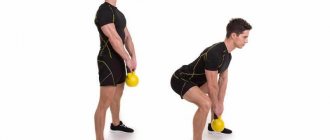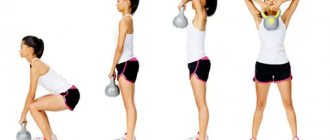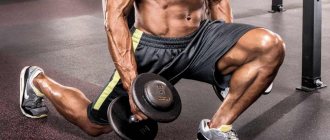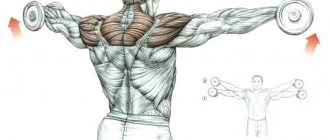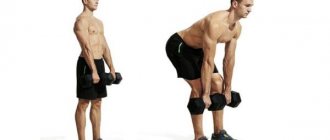What muscles will work when performing this exercise. Basics and nuances of competent technology, useful tips. The first thing that distinguishes a well-pumped torso is its massive shoulders. In this case, the main formative role is played by the middle bundle of deltas. To work it out, an effective and easy-to-perform exercise has been created - swinging dumbbells to the sides.
What are its features? What errors are possible? How to perform swings correctly? These and a number of other points are discussed in this article.
Video Standing Dumbbell Raises to the Sides
Initial position:
- Take dumbbells of optimal weight in your hands and hold them on the sides of your hips with a neutral grip (alternatively, you can hold the weights in front of you or even behind you).
- Place your feet shoulder-width apart and bend your knees slightly.
- Lean forward slightly and tighten your abs.
Movement:
- As you exhale, keeping your body straight and your gaze directed forward, using the force of your middle deltoids, dynamically move the dumbbells along arcing paths strictly to the sides. At the very beginning of the movement, bend your elbows at a small, fixed angle.
- Stop the implements at the line where your shoulder is parallel to the floor.
- Perform a 1-2 second peak contraction hold at this point.
- Inhaling, slowly lower the projectiles to the starting position
Video Lifting dumbbells through the sides for girls
This movement has only a few technical features. They are aimed at ensuring that the load does not shift to the anterior and posterior bundles of the deltoid muscles. The front bundles raise the arms, the rear bundles pull them back. It’s simple - you don’t need to allow a swing with a clear emphasis on bringing your shoulder blades together and swinging forward with dumbbells swinging in front of your chest.
How to perform the movement:
- Stand directly in front of the mirror so that you can see your movements;
- Take dumbbells in your hands with minimal weight, but such that you can feel it;
- Move your forearm to the side, along an arched path, raising your elbow to the side, but not higher than your shoulder;
- Elbows slightly bent;
- The dumbbells in the hands turn in the same direction as the movement;
- When we move our arms to the sides, the little finger is at the top, the thumb is at the bottom, this causes the dumbbells to turn;
- Lifting and lowering are performed smoothly and slowly, without cheating the body and additional unnecessary movements
In normal mode, the movement is performed for 10-12 repetitions. But there are also special cases. For example, a person has very responsive slow muscle fibers and needs high repetitions or statics, that is, holding dumbbells at the top point. Or an option with a relatively low-repetition regime is possible, if the opposite is true. Here it is important to observe yourself and do what the body responds to.
Important: the exercise should not be performed using inertial force in any of the options. If you need to push with your legs, jump, or move your body, the weight is too heavy and needs to be reduced.
The following options for performing the exercise are distinguished, depending on the position of the body:
- swing dumbbells through the sides while standing;
- swing dumbbells to the sides in an inclined position;
- swing dumbbells from the sides while sitting.
If we consider performing the exercise in a standing and sitting position, the execution technique does not change.
As for working in an incline, the target muscle changes here - the main load falls on the rear delta. At the same time, the middle delta is involved, but in a secondary way. Therefore, we propose to analyze the technique of performing it in a standing position and in a tilted position.
Place your feet shoulder-width apart, bend your knees slightly. Lower your arms with dumbbells along your body, dumbbells located in front of your thighs. The elbows are also slightly bent. Keep your shoulders back and your back straight. Lock the position. In the future, only the deltoid muscle works.
As you exhale, raise your arms with the dumbbells to shoulder level. A very important point here is the position of the elbow. The elbow joint tends upward when lifting. And at the top point it is located above the forearm. The hand is also turned upward with the little finger.
As you inhale, lower your arms with the dumbbells down to the starting position. Repeat the exercise without delay at the bottom point.
Common execution errors:
- do not lower your elbows below your forearm;
- do not round your back;
- do not make sudden jerks. To do this, you should choose the weight of the dumbbells in such a way as to perform the required number of repetitions efficiently.
In the starting position, the dumbbells are located in front of you. Palms facing each other. The body is slightly tilted forward, there is a deflection in the lower back, the knees are slightly bent.
The arms are bent at the elbows and rigidly fixed throughout the entire set of the exercise at an angle of approximately 120°. Shoulders slumped.
From the bottom point, as you exhale, begin to raise the dumbbells. Move your elbows to the sides and up, and as you move, also turn your little finger up. As soon as your elbow reaches shoulder level, pause a little, and while inhaling, begin to slowly lower the dumbbells down in front of you.
All movement occurs in the plane of the shoulders. No forward or backward deviations are allowed. At the bottom point, do not bring the dumbbells close to each other and do not pause, stop the movement in the hip area and immediately begin lifting - this way you will not allow the target muscles to rest.
Throughout the exercise, feel the contraction of the middle bundle at the top and its stretching at the bottom. This small muscle will simply burn from swelling with blood if you do everything correctly.
For the greatest effect of isolation and concentration, perform dumbbell swings with one hand. It really works and allows you to train more effectively.
Dumbbell side swings are a fairly popular exercise among athletes for the following reasons:
- The exercise can be performed with only one hand. This is convenient if, for example, you have an injured hand.
- Allows you to work both shoulders symmetrically.
- Allows you to locally work the middle or rear deltoid, depending on the variation of the exercise.
To see results as soon as possible and not get injured during training, you should adhere to the following recommendations:
- Stick to a moderate pace and concentrate on working the target muscle.
- Train one muscle group more than once a week. Determine for yourself a day to train the upper shoulder girdle and back and include arm swings with dumbbells in the training program for that day.
- Perform the exercise up to 20 times in 3-4 approaches.
- Do not use heavy weights as a burden. It is important to perform the exercise technically correctly. Otherwise, the main load will be directed to other muscle groups.
- Don't neglect warming up before every workout.
- Watch your elbows. Ideally, fix the position of your hand and hold it throughout the entire set.
- swing dumbbells through the sides while standing;
- swing dumbbells to the sides in an inclined position;
- swing dumbbells from the sides while sitting.
Common execution errors:
- Core muscles: middle deltoid
- Additional - rear delta and trapezius
- Difficulty: medium
You may ask, what can go wrong when performing standing dumbbell swings on the middle part of the deltoids? The answer is, unfortunately, there is a lot you can do with the exercise, which is also called the standing dumbbell lateral raise. Next, you will see 7 common mistakes in the dumbbell swing exercise and tips on the correct technique.
The main goal of this article is to teach you how to properly swing dumbbells to the sides while standing, so that you can develop your shoulders and make them as wide as possible.
Developed deltoids (shoulders) are an important element for every athlete due to the fact that they just show you wider from the side, clearly emphasize the upper part of the arm and also let others know how serious you are in your business. And the best exercise for creating shoulder width is the standing dumbbell swing.
For many gym-goers, the overhead press is the primary foundation exercise for training the shoulders. Yes, it works, but the dumbbell lateral raise exercise is one of the best for isolated work on the middle deltoids.
Well, probably enough theory and let’s start practicing the exercise of swinging dumbbells to the sides. Let's look at these 7 mistakes one by one.
It’s kind of strange to hear from people the name “dumbbell shoulder fly” or “lateral raise of dumbbells” and the muscle group itself “outer deltoids”, well, let’s call things by their proper names and say the middle deltoid muscle or the middle deltoid. And the correct exercise is called dumbbell swings to the sides while standing. At least to show that you are knowledgeable in this area when it comes to that very rocking chair


